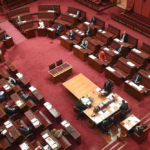A constitution shaped by distance

The Australian Constitution touches almost every aspect of Australian life providing the legal framework for all of Australia’s political and legal systems; so understanding it is critically important.
In recent years, it has influenced many things – from Australia’s response to the Global Financial Crisis, migration policies, the political achievement of marriage equality, and, in recent months, the composition of Australia’s parliament.
But the way in which the Constitution was shaped, and continues to operate, can shed light on some of its characteristics and its influence.
While many constitutions are informed by the influences of history, politics and culture; here in Australia, it’s also the influence of geography, and in particular, of distance, that has helped to shape the Australian Constitution as it has evolved.
Australia is a country defined by distance.
If we look at ‘internal distance’, the sheer size of the Australian landmass – more than 7.5 million square kilometres – means there are great distances across Australia, as well as between the main population centres in the States and Territories.
But, there is also ‘external distance’. Australia is geographically isolated – there are great expanses of sea from between Australia and its nearest neighbours, and even greater distances between Australia and most of the nations with whose legal systems it now shares common features and a common heritage.
The tyranny of distance?
The impact of this distance has shaped and influenced the Australian Constitution in countless ways.
The first is the federal character of the country. In other countries federalism may be a response to ethnic or linguistic difference, in Australia it is largely due to distance, historically and now.
Patterns of British settlement were dictated in large part by Australia’s geography and topography. Settlements were established in hospitable areas spread out along the Australian coastline.
But this distance between settlements contributed to the development of independent, self-governing colonies, which centred around those main settlements, but also covered great swathes of the Australian landmass.
The union of these six powerful colonies (now the States) would have been politically impossible if it weren’t for central role of federalism in the Constitution. This ensured, that this union “created a new State, without destroying the old States”.
The Constitution confirms the territorial boundaries of the States, and preserves the States as self-governing polities with extensive legislative, executive and judicial authority. The political relevance of the States to the institutions of federal government is assured by things like the aspects of the design of the Senate and the House of Representatives, as well as the referendum procedure.
But distance has also had an impact on Australia’s relationship with international law.
Australian constitutionalism’s resistance to the direct influence of the international legal order is unusual.
Australia is a strictly dualist legal system – this means that it is a system in which international law, including treaties to which Australia is a signatory, has no domestic legal effect without implementing legislation. Save for a single reference to treaties, international law isn’t mentioned in the Australian Constitution.
To some extent, Australia’s arms’ length relationship with international law can be attributed to its physical distance from the troubles of the rest of the world. In addition, the Asia-Pacific region in which Australia is located, has no supranational legal arrangements of the type that have eliminated or moderated dualism in other countries.
The shrinking modern world
The collapse or compression of distance, due in part to technological and economic advances, as well as increased migration, has also played an important constitutional role.
In at least one sense, distance can be said to have brought about its own demise. The peace and prosperity that have been the product of Australia’s distance have attracted migrants from all over the world, resulting in a diverse and multicultural population.
And this has had some unintentional impacts on the constitution.
This is evident when it comes to issues like the constitutionality of Australia’s laws and policies of mandatory immigration detention. Under these laws and policies, asylum seekers, refugees, and others who travel to Australia by boat are subject to mandatory detention of uncertain length; recently, in severe facilities in third-countries.
Both the presence of boat arrivals themselves and the use of third-country facilities can be seen as aspects of the collapse of Australia’s external distance.
Those laws and policies have been repeatedly subjected to constitutional review, and with a few notable exceptions, they have withstood it. But, ongoing constitutional review of these laws and policies continues to contribute to the incremental development of constitutional law.
This includes defining the proper relationship between international agreements and domestic migration law; the rights and immunities of non-citizens; the breadth of the executive power to contract; and the limits on the executive power to detain.
Whether development of these aspects of the law by courts could yield a constitutional solution, however, remains to be seen.
A relevant Constitution
There’s also the ongoing debate around Section 44 of the Constitution, which, amongst other things, disqualifies dual citizens from sitting in Parliament.
Section 44 has seen the disqualification or resignation of 15 members of Parliament on citizenship grounds. A recent report by the Joint Standing Committee on Electoral Matters has recommended a referendum on the repeal or amendment of Section 44.
One of the rationales for reform is that Section 44 now operates more strictly and sweepingly than intended. In fact, Section 44 presents a barrier to nomination for nearly half of all Australians; around 11 million Australians (46 percent of the population) were either born overseas, or have one or more parents who were born overseas.
These examples are not exhaustive: there are countless ways in which distance, in its various forms, has shaped the Australian Constitution, and the development of Australian Constitutional law.
Australia’s distance may be seen in the push to constitutionally recognise Australia’s First Peoples. It represents a long-overdue attempt to constitutionally resolve the original collapse of distance – the British colonisation of Australia at the expense of its Indigenous people. It’s also tangible in the ongoing push for an Australian Republic.
What this all highlights is that distance has historically been and remains, an important influence on the development and operation of the Australian Constitution.
By grasping this influence, it may contribute to our understanding, and perhaps resolving, of significant issues in Australian constitutional law.
This article was written by Joshua Quinn-Watson, Professor Adrienne Stone and Professor Cheryl Saunders. The article was published by Pursuit.
Professor Cheryl Saunders and Professor Adrienne Stone are the editors of The Oxford Handbook of the Australian Constitution. The Handbook was launched by the Chief Justice of the High Court, Susan Kiefel AC, at Melbourne Law School on Friday 25 May.
Written by a team of experts drawn from academia and practice, the Handbook provides readers with a reliable and up to date source of knowledge, understanding and insight into the Australian Constitution.
Professor Adrienne Stone is the Kathleen Fitzpatrick Laureate Fellow, Redmond Barry Distinguished Professor and Director of the Centre for Comparative Constitutional Studies at the Melbourne Law School in the University of Melbourne.












